Inuit find new home in Canada's capital
 Print This Print This
By Leyland Cecco, Al Jazeera
Al Jazeera
Thursday, Nov 27, 2014
The Inuit migration south to Ottawa has picked up speed, a challenge for those used to traditional life
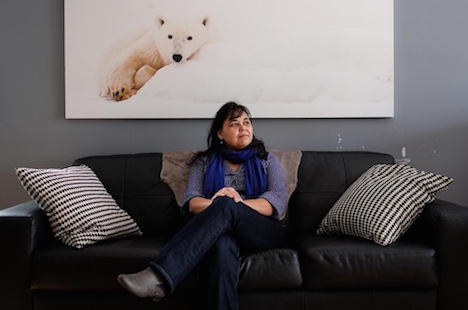 |
| Lynda Brown, president of the Inuit Non-Profit Housing Corporation for the past eight years in Ottawa, still remembers when she told people she was Chinese, thinking she would fit in better.Leyland Cecco |
Dion Metcalfe pulls up his shirt to reveal an inukshuk tattooed onto his stomach. The stone cairn, used to guide or mark a path in the North, is coupled with a compass and the names of his family.
“My Inuit name is Aalla; it means stranger,’’ he says as his fingers trace the Inuktitut syllabics.
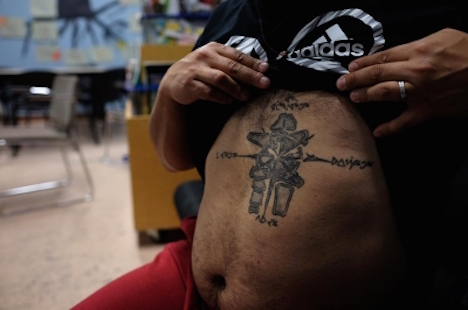 |
| Dion Metcalfe’s tattoo of an inukshuk, or stone cairn. Leyland Cecco |
For most of his life, Metcalfe has been a stranger. Born to an Inuit father and Dutch mother in St. John’s, Newfoundland, on Canada’s east coast, the family moved to Ottawa when he was six months old. His father went to a residential school, a system notorious for its abuse of students, and what he suffered there he inflicted on his son. Metcalfe grew up bullied at school and at home, caught between two cultures.
Long known as nomads of the Arctic, the Inuit have been migrating to southern urban centers for nearly a half-century now. To outsiders, the Arctic is a barren polar desert, but the Inuit communities thrived there for thousands of years, braving winters with little daylight, and in some areas, temperatures that dipped below -50°C. Dog sleds were once used both for day-to-day travel and hunting, these days largely replaced by planes and snowmobiles. Because of the uniquely isolated nature of life in the North, myths about Inuit lifestyle, such as kissing with noses, still persist.
 |
| Dion Metcalfe, in black, sits with youth at an after-school program meant to provide Inuit children with cultural activities.Leyland Cecco |
While only a sliver of the national population —the Inuit number about 60,000 in a land of 35 million — this group has seen perhaps the largest change to their way of life just over the last few decades. Metcalfe’s father was born a nomad, in an igloo. But his son has experienced none of the culture that comes with his heritage.
“We went from igloos to iPods in one generation,’’ he says.
But now that exodus is happening faster. In the Canadian North, access to quality health care is rare. Each year the number of patients being flown down for care in southern cities continues to rise. Life is costly, with grocery bills for a single parent of one child exceeding $600 per week, while earnings average $19,900 per year. Accessible post- secondary education is lacking. Housing scarcity also compounds the problem.
“The housing situation is ridiculous. Twenty-one people living in a three-bedroom house? That’s a norm,” says Lynda Brown, president of Ottawa’s Inuuit Non-Profit Housing Corporation. “They call it the hidden homeless because it’s not like anyone lives on the streets. People won’t let that happen- family members take people in.”
In Canada’s capital, a new community of Inuit is emerging from this migration. Called the urban Inuit, the name evokes not only a geographic shift, but also a challenge to identity and the shedding of igloos and barren landscapes as archetypes.
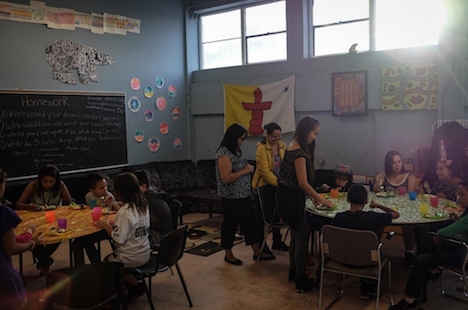 |
| Children eat dinner at an Inuit after-school program. Leyland Cecco |
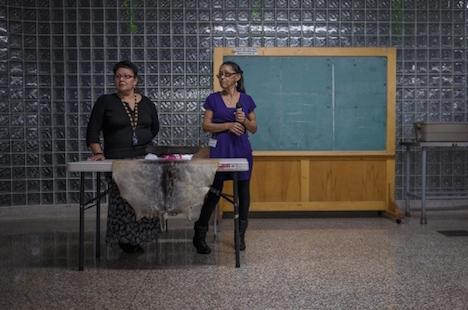 |
| Announcements are made at the annual general meeting of the Ottawa Inuit Children's Centre. Leyland Cecco |
Conservative math offered by various community groups suggest the population has eclipsed 3,000 in Ottawa. Between 2006 and 2011, the Inuit population in the province of Ontario jumped by 64 percent. The population is growing, and growing fast. The rate of urbanization has gone from 15 percent living in urban areas in 2001, to the potential for 50 percent within the next 10 years, say service providers. Federal government statistics show the Inuit population in Ottawa at only 735, but experts ascribe that to low self-reporting on census documents. This results from a variety of factors, including transient populations and a mistrust of government. Some members of the Inuit community refuse to identify as aboriginal, viewing it as a term referring to indigenous populations in the South, rather than the Inuit. Because Inuit are often lumped in with other aboriginal groups on the census, the true numbers are depressed. But, lower official numbers impedes the delivery of state-run social programs and means a smaller share of available federal funding.
While urban migration is present in all of Canada’s aboriginal population, the differences many Inuit face are unique. Often, they come from communities of only a few hundred, with perhaps a dozen cars in the village. Arriving in the city, just learning to cross the street or take a bus is reason to celebrate, says Lynda Brown. Her mother, after living in Ottawa for 30 years, still feels anxiety around tall buildings downtown.
In communities up north, smiling is a way of telling others that everything is going well. If one passes by another and doesn’t smile, this sends a strong message there’s something wrong. But things are different in densely populated areas. “When an elder came down, she was smiling so much her cheeks were tired because there are so many people,” says Seemeega Aqpik as he stirs a simmering pot of caribou stew for an elders’ lunch.
After leaving his community of a few hundred just three years ago, life in the city has been a profound change. He helps co-ordinate a weekly men’s group to help those suffering from addiction issues and other stresses to have an outlet to talk about personal challenges.
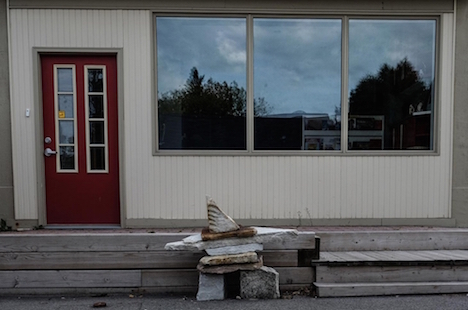 |
| An inukshuk marks the location of the Youth Program building run by the OICC.Leyland Cecco |
The urban Inuit community is not just a homogenous group of recent arrivals. There are some who have lived most of their lives in the city, strangers to their ancestry.
“My dad went to residential schools, so he didn’t want any of us going through what he went through: the shame of his language; the shame of who he was,” says Metcalfe of his absent identity.
Many Inuit have connections not only to family members who were in the residential schools, but also to communities that were deliberately broken up and relocated by government policy.
Hunters, who had long provided for their communities, could no longer hunt the land and were reduced to reliance on government aid. These scars of government policy mark the lives of many. Others who grew up in urban areas share this experience.
“I actually told people I was Chinese, because in Edmonton there was a huge Chinese population, and I’d rather fit in there,” says Lynda Brown. “My mom was convinced that for us to succeed in school, and to succeed in life, learning English was the only way to go. She stopped speaking Inuktitut to us when I was three.”
On the surface, there is a temptation to liken the Inuit challenges to the problems facing indigenous populations across the country, with low rates of education and employment, and high rates of foster care and incarceration. However, as one caseworker at the community outreach center noted, the numbers are amplified with the Inuit demographic. For example, 71 percent of those identifying as First Nations have a high school diploma, where as only 50 percent of Inuit have one.
Over time, collective identity and self-esteem were stripped through assimilation and racism, says Metcalfe. A report released by the City of Ottawa lists instances of Inuit being told to ‘go back home’ when they are mistaken for residents of Asian descent or being denied job interviews because of stereotypes labeling them as ‘lazy’. Rather than sliding further however, the community pushed back hard by establishing education and resource centers that not only provide social services, but also serve to instill cultural pride in Inuit youth.
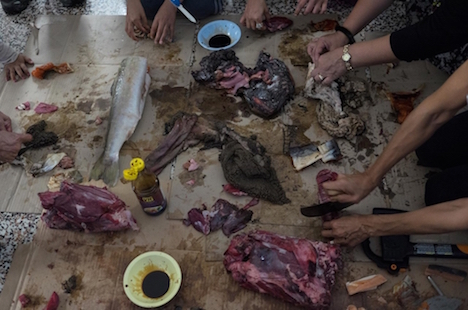 |
| Frozen arctic char, seal and caribou are eaten on the floor in the traditional manner of Inuit culture at an event organized by the OICC.Leyland Cecco |
In order to preserve the language and other cultural practices, the urban Inuit must display the same ingenuity and adaptability used by previous generations to flourish in one of the most inhospitable regions on the planet. Like its speakers, the language is agile and adaptive in the face of change. In the past throughout Canada, more than 65 aboriginal languages were spoken. In a testament to its staying power, Inuktitut retains its strong oral tradition in the North, being one of the few indigenous languages still widely spoken amongst its population. In the South, it is in the midst of a revival.
For decades, both the Anglican and Catholic churches had a large presence and influence in the Arctic, much of which has since been judged as a dark period in its history. Despite the Church’s record in the North, one Anglican church is an unlikely southern ally in the preservation of the Inuit language.
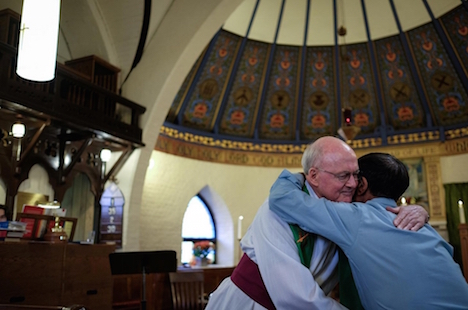 |
| Reverend Roger Briggs, who delivers Sunday sermons in Inuktitut, hugs a parishioner at St. Margaret’s Anglican Church.Leyland Cecco |
In Ottawa, Reverend Roger Briggs, who spent fifty years up North as a priest and community worker gives weekly Sunday sermons to a congregation of 45, using a mixture of Inuktitut texts and interpreter Aigah Attagutsiak. The church’s aim is to provide not only a forum for community discussion, but also to do so in Inuktitut. For those now living in the city, the language serves as a guide for navigating the confusions of a new way of life. Tears are shed on one Sunday morning during the sermon, as Briggs weaves English and Inuktitut together in a discussion of personal tragedy and coping. “We need to have these kinds of discussions. But what is the vocabulary for it? You often don’t know what you’ve lost until you’ve lost it.” To many of the congregation, life in the North is a distant memory, anchored by language.
The changes and migration coalesce around a rapidly evolving Inuit identity. “Parents who may not have self-identified as Inuit, who didn’t learn the culture, have children who are now saying ‘we want to know who we are’,” says Christine Lund, Coordinator at Tungasuvvingat Inuit, a community center set up almost 30 years ago to provide social services unique to the fledgling diaspora. As cultural losses deepened, members of the community worked to preserve many of the traditional practices of their ancestors. “We were part of that uprising, the gaining of control and power and regaining self-esteem. It was a lot of work by a lot of people.”
While prejudice still follows the community, it is now met and resisted by a fierce pride in heritage and culture through the steady proliferation of Inuit-centric educational opportunities. For some, like Metcalfe and Brown, the community push for preservation has led them to rediscover their Inuit heritage. Brown travels around the world as a traditional throat-singer, and Metcalfe, through interactive traditional hunting games, educates youth in public schools about Inuit culture and history. They also both work at the Ottawa Inuit Children’s Centre (OICC). The education center was set up eight years ago to provide both education in Inuktitut and immersion in Inuit culture. Both have had their children go through the different programs offered by the OICC.
The programs promote Inuit culture and language. Students learn storytelling and oral history from cultural teachers, and once a month ‘country food’ is served as snacks. The foods, staples of the North, are often caribou, seal and artic char. All are eaten frozen or dried in keeping with traditional preparation. The youth also have the chance to meet with elders, an important facet of the culture.
For many Inuit in the city, these programs represent a lifeline back to ancestry for a youth with a culturally ambiguous identity. But for those who grew up strangers to their culture, it means something more. Metcalfe smiles after watching his daughter throat sing. In a relatively short period of time, he’s watched urban Inuit pride grow in tandem with interest from the youth he educates in public schools. “Instead of shaming someone for being Inuit, they want to know more about it. Before they were scared of it, now they’re in wonder of it.”
 |
| A child plays at an OICC after-school program.Leyland Cecco |
Source URL
|
 Print This Print This

|

